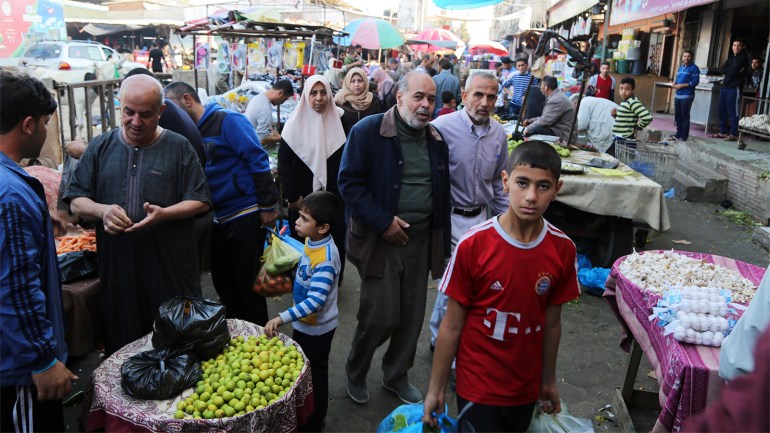The residents of the Gaza Strip received Eid Al-Adha this year, in light of the bad economic conditions described by observers as "catastrophic."
The purchasing movement varied from one market to another, according to the physical capabilities of the sector's residents and the order of their priorities, as a large segment of them suffers from a complete lack of purchasing power.
And while the clothing and confectionery markets complain of poor purchasing, the sacrifice market recorded a "good" turnout.
This comes in light of the low prices of livestock this year, and a number of local and regional relief organizations went to buy sacrifices to distribute their meat to the poor during the feast, according to a report published by the Anatolia Agency.
the siege
Economists and dealers attribute the deterioration of the economic situation to the continued Israeli blockade imposed on the sector for the 14th year in a row, along with the repercussions of the global crisis of Corona, and its negative repercussions on all economic and productive sectors.
By the beginning of 2020, the poverty and unemployment indicators rose to 52% and 50%, respectively. Besides, the financial crisis of the Palestinian National Authority has deepened the economic crisis in Gaza.
Since the beginning of last June, the government has not received clearing funds for the previous May, which is estimated at $ 190 million per month, and represents 63% of the total revenue.
Economic conditions
Maher Al-Tabbaa, director of public relations and information in the Chamber of Commerce and Industry, says that "all indicators on the ground indicate a catastrophic economic, living and humanitarian situation."
In an interview with Anatolia, Al-Tabbaa shows that the Gaza Strip is already suffering from a deterioration in economic conditions, due to the Israeli blockade imposed on it.
He explains that the Corona pandemic crisis deepened the economic crisis, and recorded dangerous rebounds on all economic and productive sectors. "We have monitored 45,000 people out of work due to the Corona crisis."
He added, "And the financial crisis experienced by the Palestinian Authority, which was reflected in the payment of part of the salaries of its employees, cast a negative shadow on the economic situation in Gaza ... These salaries are the main driver of the economic wheel of the markets."
The value of cash liquidity from the salaries of the Authority's employees in Gaza, which is pumped into the markets, is about 30 million dollars a month, as the value of this liquidity decreased due to the financial crisis by more than 60%, according to Al-Tabaa '.
PPC weak
Ala Hamid, 26, a clothes seller, in the Jabalia refugee camp market in the northern Gaza Strip, complains about the lack of people in buying holiday clothes this year.
He says that the market turnout during the days leading up to Eid al-Adha did not meet expectations. "We were counting on the Eid season to sell our goods, as we suffer throughout the days of the year a state of recession, as a result of low purchasing power."
"We usually rely on the holiday and school seasons to cover our losses, but this year, with the accumulation of crises and their impact on the economic situation, the commercial movement has been greatly affected," he added.
He notes that the complex economic crisis "changed the priorities of citizens, and made the purchase of holiday supplies secondary matters."
In turn, home appliances dealer Ahmed Sami, 38, says citizens are visiting the market this year "for the sake of watching, but without buying."
"Eid is considered a season for selling several items of household items, but this year citizens are satisfied with taking a look at it without initiating a purchase," he said, expressing his hope that the economic conditions will improve.
Livestock market
In the weekly cattle market near the Nusseirat camp in the central Gaza Strip, the young Mahmoud Al Rayyan is inspecting his sheep for sale.
These sheep have been cultivated throughout the year by Al Rayyan, with the help of his brothers, to sell them during this season, as they constitute the primary source of livelihood for them, and the only profession they are good at. He says, "The popularity of sacrificing for this Eid is rather good."
Al-Rayyan attributed this to the "low prices of livestock from last year," pointing out that this matter had caused them "great losses" that prevented them from being able to provide the necessary life requirements.
He recalled, "We used to sell sheep at an average price of $ 350, but this year it barely reached $ 305, and we are forced to sell to pay our financial obligations as the price of feed and medicines for livestock."
prices drop
Adham Al-Bassiouni, a spokesman for the Ministry of Agriculture in the Gaza Strip, describes the percentage of demand for livestock markets in Gaza as "good", pointing out that "the quantities of livestock available in the markets, estimated at 12 thousand head of calves, and 30 thousand head of sheep, are commensurate with the current conditions."
He explains that the low prices of livestock in the Gaza Strip "makes the purchase of sacrifices within the reach of citizens."

